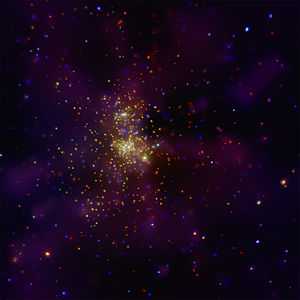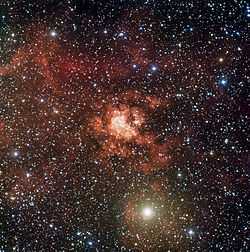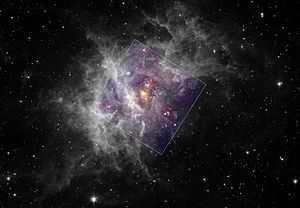Westerlund 2


Westerlund 2 is a young massive obscured star cluster with an estimated age of about one or two million years. It contains some of the hottest, brightest, and most massive stars known. The cluster contains a dozen of O stars, of which at least three are eclipsing binaries, many pre–main sequence stars and two Wolf-Rayet Stars: the binary WR20a and the single star WR20b, all of spectral type WN6ha. They are probably not actually Wolf-Rayet stars, i.e. they are core-hydrogen-burning stars, just like the sun, but due to their large mass loss rate they appear to be Wolf Rayet stars.
It was shown recently that the core of the cluster contains several examples of rare very hot stars (Rauw et al. 2007, A&A, 463, 981). Just outside the cluster a massive eclipsing binary WR20a is found at 30 arcseconds (about 1.1 pc in projection), the bright yellow spot just on the lower right side of the cluster center.
As its name indicates, the Westerlund 2 cluster was discovered by Bengt Westerlund in the sixties (Westerlund 1961, PASP, 73, 51 and 1968, ApJ, 154, L67 – see http://vizier.u-strasbg.fr/cgi-bin/Dic-Simbad?Cl%20Westerlund ) but its stellar content was assessed only in later years (Moffat et al. 1991, AJ, 102, 642; Rauw et al. 2007, A&A, 463, 981). WR20a has also been known since the sixties (1966, CoBos, 35, 1) but its binarity was only discovered in 2004 by a Belgian team.
WR20a
| Observation data Epoch J2000 Equinox J2000 | |
|---|---|
| Constellation | Carina |
| Right ascension | 10h 23m 58.02s |
| Declination | −57° 45′ 48.9″ |
| Apparent magnitude (V) | 15.0 |
| Characteristics | |
| Spectral type | WN6ha + WN6ha |
| U−B color index | ? |
| B−V color index | −0.33 |
| Variable type | Eclipsing |
| Astrometry | |
| Radial velocity (Rv) | 0.0 km/s |
| Proper motion (μ) | RA: 0.0 mas/yr Dec.: 0.0 mas/yr |
| Parallax (π) | 0.0 ± 0.0 mas |
| Distance | 20000 ly (7900 ± 600 pc) |
| Absolute magnitude (MV) | 13.5 |
| Details | |
| Mass | 82.7 ± 5.5 and 81.9 ± 5.5 M☉ |
| Radius | 19.3 ± 0.5 and 19.3 ± 0.5 R☉ |
| Luminosity | (1.15 ± 0.15) 106 L☉ |
| Temperature | 43000 ± 2000 K |
| Metallicity | ? |
| Rotation | ? |
| Age | ? years |
| Other designations | |
WR20a was discovered in 2004 to be one of the most massive binary systems known, for which the masses of the components have been accurately measured. Each star in the system has about eighty times the mass of our sun (Rauw et al. 2004, 420, L9, Rauw et al. 2005, A&A, 432, 985 and Bonanos et al. 2004). It is not clear why this system is located away from the center of the cluster. It is possible that the system was formed in the core, but that it got ejected by dynamical interactions.
Every 3.6 days the two star in this system revolve around each other. Although the stars are in very tight orbit, both stars in the system are detached (see e.g. Rauw et al. 2007, A&A, 463, 981 and Bonanos et al. 2004). It is expected that within a million years the two will expand and come into contact. A large nitrogen abundance has been measured on the surface of the stars (Rauw et al. 2005, A&A, 432, 985), about six times the abundance of nitrogen measured in the sun. This nitrogen is probably produced in deeper layers of the star and pushed towards the surface by rotational mixing.
A collision between the two winds of the systems has been detected in the visible as well as in X-rays (Rauw et al. 2005, A&A, 432, 985; Naze et al. 2008, A&A, 483, 171). The X-ray emitting region is quite extended since it does not suffer from any eclipse.
WR20b
WR20b seems to be single star, slightly fainter than the faintest star of WR20a, though its X-ray emission is quite peculiar (see Naze et al. 2008, A&A, 483, 171).

References
- Simbad
- Chandra Image of Westerlund 2
- Moffat et al. 1991 : The first study of the stellar content of Westerlund 2
- Rauw et al. 2004: The discovery of the binarity of WR20a
- Bonanos et al. 2004: The light curve of WR20a
- Rauw et al. 2005: The full analysis of WR20a
- Rauw et al. 2007: The content of Westerlund 2
- Naze et al. 2008: The X-ray view of Westerlund 2
External links
- Astronomy Picture of the Day - Young Star Cluster Westerlund 2 26 June 2010